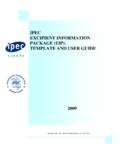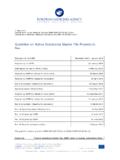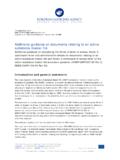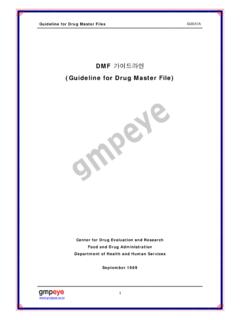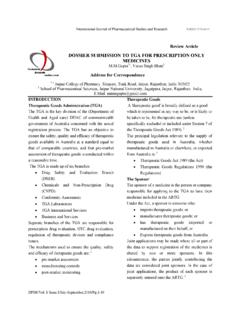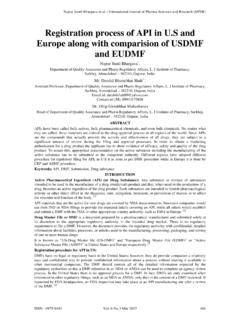Transcription of Excipient Master File Guide - ipecamericas.org
1 The International Pharmaceutical Excipients Council of the Americas Excipient Master File Guide Copyright 2004 The International Pharmaceutical Excipients Council of the Americas (IPEC-Americas ) The International Pharmaceutical Excipients Council of the Americas Excipient Master File Guide ACKNOWLEDGEMENTS This Guide was developed by representatives of many of the member companies of the International Pharmaceutical Excipients Council of the Americas (IPEC-Americas). IPEC-Americas is a based industry association comprised of Excipient manufacturers and their pharmaceutical customers. The contributing individuals are listed below.
2 Christopher C. DeMerlis, Chair Colorcon Eunice Cuirle FMC Biopolymer Connie Dillon Noveon, Inc. John Fratus Roquette America, Inc. Mitchell B. Friedman, Abbott Laboratories Sidney A. Goode, Pharm. D. Dow Chemical Company Rodney J. H. Gray, Hercules Robert K. Hinderer, Noveon, Inc. Elaine Knight, Johnson & Johnson Pharmaceutical Research and Development, LLC R. Christian Moreton, Idenix Pharmaceuticals, Inc. David R. Schoneker Colorcon Marshall Steinberg, International Pharmaceutical Excipients Auditing, Inc. Bruce Trela Abbott Laboratories Katherine Ulman Dow Corning Corporation Copyright 2004 The International Pharmaceutical Excipients Council of the Americas (IPEC-Americas ) TABLE OF CONTENTS Pages ADMINISTRATIVE SECTION.
3 1 1. 2. General 3. Maintenance and Management of Change ..2 4. Transmittal Original Annual 5. Letters of Authorization ..4 CORE TECHNICAL DOCUMENT 1. Summaries ..5 2. Description, Characterization and Intended Intended Characterization of Excipients ..6 3. Facilities 4. Origin of Starting Manufacturing 5. Process Controls During Manufacture and 6. 7. Reference Standards or 8. Batch 9. Certificate of 10. 11. Excipient Copyright 2004 The International Pharmaceutical Excipients Council of the Americas (IPEC-Americas ) Pages 12.
4 Nonclinical Safety Introduction and Choice of Safety Assessment Route of Exposure & Estimated Daily Impurities 13 Nonclinical Safety Overview and Tabulated Toxicology Order of Presentation of Information within Routes of administration should be ordered as follows:..15 Nonclinical Safety Toxicology Study Use of Published Safety Margin of 13. Environmental Assessment ..19 14. 15. 16. Appendix I. Flavors and Color 1 Copyright 2004 The International Pharmaceutical Excipients Council of the Americas (IPEC-Americas ) ADMINISTRATIVE SECTION 1. SCOPE The focus of this Guide is the United States; however, the intent is to develop a Guide with global application.
5 A Type IV Excipient Drug Master File (DMF1) is a submission to FDA containing information that may be used to support an Investigational New Drug Application (IND), New Drug Application (NDA), Abbreviated New Drug Application (ANDA), Biological License Application (BLA), Veterinary Drug Application, another DMF, or an Export Application. An Excipient DMF should follow the harmonized structure and format of the ICH Common Technical Document (CTD) for presenting chemistry, manufacturing, and controls and safety information. This same information can be used for marketing authorization applications worldwide. An Excipient is defined as any substance other than the active pharmaceutical ingredient (API) in a drug product which has been appropriately evaluated for safety and functionality and is included in a drug delivery system.
6 Excipients may be used to aid in the processing of the drug substance during manufacture, to protect, support or enhance stability and bioavailability. DMF's can cover excipients that may be comprised of single ingredients, mixtures or co-processed materials. Each type of Excipient may require a slightly different approach when establishing the design of the DMF to facilitate the review process by FDA (the Agency). 2. GENERAL INFORMATION There are many administrative responsibilities for the Agency and the DMF holder such as processing of the DMF documents and the filing of letters of authorization and annual updates.
7 An Excipient DMF is not required by law or FDA regulations. It is submitted solely at the discretion of the holder. It is not approved or disapproved. The DMF is maintained as a confidential document that cannot be submitted to third parties without the written agreement of the Excipient ingredient manufacturer. The DMF contains manufacturing and controls information and technical data to support the safety and quality of the Excipient . If an agent is appointed (person appointed by a DMF holder to serve as the contact for the holder), the DMF must contain a signed letter submitted to the FDA stating the agent s name, address, and scope of responsibilities.
8 1 Type IV DMF 2 Copyright 2004 The International Pharmaceutical Excipients Council of the Americas (IPEC-Americas ) A Statement of Commitment is a signed statement by the DMF holder certifying that the DMF is current and that the DMF holder will comply with the statements made in it. The holder of the DMF for an original submission receives an acknowledgement from the FDA assigning a number to the DMF once filed. The DMF must be in the English language. Whenever a submission contains information in another language an accurate English translation must be included. 3.
9 MAINTENANCE AND MANAGEMENT OF CHANGE The regulatory responsibilities of a DMF holder are cited in 21 CFR A DMF is required to contain the listing of persons authorized to refer to a DMF. If the DMF holder adds, changes, or deletes significant information in the file (except annual updates of authorized users) the holder shall notify in writing, each person authorized to reference that information. There are 2 types of subsequent communication to the Agency concerning the DMF; a report informing the Agency of a significant change in the manufacturing process and the annual report. The DMF holder should evaluate all changes in the manufacture of the Excipient from that previously listed in the DMF using the provisions of IPEC-Americas Significant Change Guide for Bulk Pharmaceutical Excipients.
10 If the change is found to be significant, the Agency must be notified promptly. Otherwise there should be an annual report to the Agency clearly identifying all changes and additional material incorporated into the DMF since the last report was filed. The report to the Agency, either reporting a significant change or annual report, must include a transmittal letter concerning the specifics of the update and should contain the complete Letter of Authorization (LOA) list. If there is no annual report for the DMF filed for 2 consecutive years, the FDA has the right to consider the DMF inactive. The IPEC-Americas Significant Change Guide for Bulk Pharmaceutical Excipients establishes uniform considerations for evaluating the significance of changes involving the manufacture of bulk pharmaceutical excipients (BPE).

